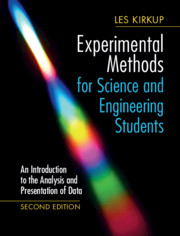 Experimental Methods for Science and Engineering Students
Experimental Methods for Science and Engineering Students Published online by Cambridge University Press: 24 August 2019
Data provide the foundation upon which understanding in science and engineering is built. A basic requirement is that data are expressed in units that are recognised and accepted internationally. This chapter considers the most commonly adopted system of units: The International System of Units. The chapter also considers how to express data, for example using scientific notation. The importance of presenting data clearly in tables is emphasised.
In some situations, it is possible to estimate the size of values likely to emerge from an experiment, prompting our attention to be alerted when the values obtained differ considerably from our estimation. Exploring the reasons for a discrepancy can lead to improved insight of the experiment or perhaps hint that a mistake has occurred, for example when converting units.
To save this book to your Kindle, first ensure [email protected] is added to your Approved Personal Document E-mail List under your Personal Document Settings on the Manage Your Content and Devices page of your Amazon account. Then enter the ‘name’ part of your Kindle email address below. Find out more about saving to your Kindle.
Note you can select to save to either the @free.kindle.com or @kindle.com variations. ‘@free.kindle.com’ emails are free but can only be saved to your device when it is connected to wi-fi. ‘@kindle.com’ emails can be delivered even when you are not connected to wi-fi, but note that service fees apply.
Find out more about the Kindle Personal Document Service.
To save content items to your account, please confirm that you agree to abide by our usage policies. If this is the first time you use this feature, you will be asked to authorise Cambridge Core to connect with your account. Find out more about saving content to Dropbox.
To save content items to your account, please confirm that you agree to abide by our usage policies. If this is the first time you use this feature, you will be asked to authorise Cambridge Core to connect with your account. Find out more about saving content to Google Drive.